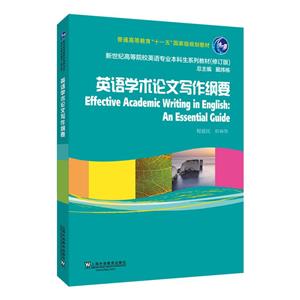扫一扫
关注中图网
官方微博
本类五星书更多>
-
>
新东方 背单词,记住这200个词根词缀就够了
-
>
(精)古代汉语三百题
-
>
增广贤文
-
>
优秀的绵羊
-
>
北京大学
-
>
新视野大学英语(第三版)读写教程.2
-
>
初中数学应用题解规律
英语学术论文写作纲要:an essential guide 版权信息
- ISBN:9787544679770
- 条形码:9787544679770 ; 978-7-5446-7977-0
- 装帧:一般胶版纸
- 册数:暂无
- 重量:暂无
- 所属分类:>
英语学术论文写作纲要:an essential guide 内容简介
本书编写内容深入浅出,反映了各个学科领域的研究成果;编写体例采用国家有关标准,力求科学、严谨,满足各门课程的具体要求;编写思想上,除了帮助学生打下扎实的语言基本功外,还着力培养学生分析问题、解决问题的能力,提高学生的人文、科学素养,培养健康向上的人生观,使学生真正成为我国21世纪所需要的外语专门人才。
英语学术论文写作纲要:an essential guide 目录
PART Ⅰ GENERAL FEATURES OF ACADEMlC WRITING
Chapter 1 Academic Writing:An Introduction
1.1 Academic Writing:A Definition
1.2 Characteristics of Good Academic Writing
1.2a Good Writing Calls for Critical Reading and Critical Thinking
1.2b Good Writing Involves Thoughtful Revision
1.2c Good Writing Is Directed Toward an Audience
1.2d Good Writing Achieves a Clear Purpose
1.2e Good Writing Expresses Ideas Clearly
1.2f Good Writing Pulses with Creativity
Chapter 2 Kinds of Academic Writing
2.1 Writing to Summarize
2.2 Writing to Synthesize
2.3 Writing to Explain
2.3a Writing to Inform
2.3b Writing to Explain Processes
2.3c Writing to Explain Concepts
2.4 Writing to Argue
2.4a The Logical Appeal
2.4b The Emotional Appeal
2.4c The Ethical Appeal
2.4d Five Basic Components
2.5 Writing to Propose
2.6 Writing to Analyze
2.7 Writing to Evaluate
Chapter 3 The Rhetorical Context and Characteristics of Academic Writing
3.1 The Rhetorical Context
3.1a Topic or Subject
3.1b Audience
3.1c Purpose and Role
3.2 Characteristics of Academic Papers
PART Ⅱ PROCESS OF EFFECTIVE ACADEMIC WRITING
Chapter 4 Finding a Topic
4.1 Process of Writing
4.2 Assessing Your Prior Interest and Knowledge
4.3 Narrowing the Topic—Creating a G00d Title
4.4 Techniques for Inventing
4.4a Freewriting
4.4b Brainstorming
4.4c Branching
4.4d Cubing
4.4e Questioning or Journalistic Formula
4.5 Generating New Ideas by Critical Reading
Chapter 5 Researching the Topic
5.1 Field Research
5.1a Observing
5.1b Interviewing
5.1c Using Questionnaire
5.2 Library Research
5.2a Library Sources and Materials
5.2b Taking Notes
5.3 Internet Research
5.4 Keeping Track of Your Research
5.5 A Six-Step Approach to Research
Chapter 6 Outlining
6.1 The Structure of a Paper
6.2 Sorting Out Your Notes and Other Materials
6.3 Outlining
6.3a Draft Outline
6.3b Formal Outline
6.3c Two Commonly Used Patterns of Formal Outlines
6.4 Formulating the Thesis Statement
Chapter 7 Drafting,Revising,Editing and Proofreading
7.1 Drafting
7.2 Revising
7.2a Revising for Content and Organization-Macro-revision
7.2b Revising for Details-Micro-revision
7.3 Final Editing and Proofreading
PART Ⅲ STRATEGIES FOR EFFECTIVE ACADEMIC WRlTING
Chapter 8 Organizing the Paper
8.1 Five Basic Organizational Patterns
8.1a General.to—Specific/Abstract—to-Concrete
8.1b Specific.to.General/Concrete.to—Abstract
8.1c Order of Importance
8.1d Chronological Order
8.1e Spatial Order
8.If Other Organizational Patterns
8.2 Introduction
8.2 a Narrative
8.2 b Descriptive
8.2 c Preparatory
8.2 d Corrective
8.2 e Inquisitive
8.2 f Stating a Problem
8.2 g Giving a Surprising Fact or Statistics
8.2 h Using a Striking Quote
8.3 Conclusion
8.3a Restating the Main Points
8.3b Referring Back to the Thesis(and the Introduction)
8.3c Suggesti.ng a Solution,Further Study,or Predicting an Out
8.3d Giving a Humorous Comment or Unexpected Twist
8.3e Using a Striking or Memorable Quote
Chapter 9 Strategies for Development
9.1 Definition
9.1a Sentence Definition
9.1b Extended Definition
9.1c Historical Definition
9.1d Stipulative Definition
9.2 Classification
9.2a Choosing the Principle(s)to C1assifv
9.2b Testing the Effectiveness
9.2c Explaining Each Subgroup
9.3 Example
9.3a Relevant Examples
9.3b Specific Examples
9.3c Sufficient Examples
9.4 Comparison and Contrast
9.4a Points for Comparing and Contrasting
9.4b Two Ways for Organizing Comparisoun and Contrast
9.4c Transitional Words and Phrases
9.5 Cause and Effect
9.5a Distinguishing Between Cause and Effect
9.5b Necessity,Sufficiency,and Mill,s Methods
9.5c Organizing Cause and Effect Analvsis
9.5d Transitional words and Phrase:for Cause-and Effect Analysis
9.6 Generalization
9.7 Visual Elements
Chapter 10 Use of Sources and Documentation
10.1 Importance of Using and Documenting Sources
10.2 Three Ways to Use Sources
10.3 Styles of Documentation
10.4 MLA Style
10.4a In.text Citation
10.4b Explanatory Notes
10.4c List of Works Cited
10.5 APA Style
10.5a In.text Citation
10.5b Explanatory Notes
10.5c List of References or Bibliography
10.6 中文参考文献格式
Appendix:Sample Student Academic Writings
Works Cited and Consulted
展开全部
书友推荐
- >
企鹅口袋书系列·伟大的思想20:论自然选择(英汉双语)
企鹅口袋书系列·伟大的思想20:论自然选择(英汉双语)
¥6.3¥14.0 - >
朝闻道
朝闻道
¥8.8¥23.8 - >
大红狗在马戏团-大红狗克里弗-助人
大红狗在马戏团-大红狗克里弗-助人
¥3.5¥10.0 - >
中国历史的瞬间
中国历史的瞬间
¥16.7¥38.0 - >
姑妈的宝刀
姑妈的宝刀
¥9.0¥30.0 - >
苦雨斋序跋文-周作人自编集
苦雨斋序跋文-周作人自编集
¥5.8¥16.0 - >
我与地坛
我与地坛
¥16.5¥28.0 - >
月亮与六便士
月亮与六便士
¥15.1¥42.0
本类畅销
-
新时代大学英语 读写译教师用书2
¥29.3¥39 -
新东方 背单词,记住这200个词根词缀就够了
¥8.3¥15 -
实用英语简捷语法
¥47.8¥78 -
新编英汉翻译教程
¥39.5¥55 -
新视野大学英语(读写教程4思政智慧版第3版十二五普通高等教育本科国家级规划教材)
¥35.3¥69.9 -
4.23文创礼盒A款--“作家言我精神状态”
¥42.3¥206





















